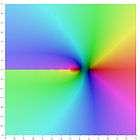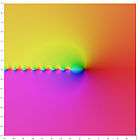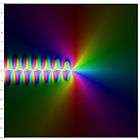Polygamma function

In mathematics, the polygamma function of order m is a meromorphic function on and defined as the (m+1)-th derivative of the logarithm of the gamma function:
Thus
holds where ψ(z) is the digamma function and Γ(z) is the gamma function. They are holomorphic on . At all the nonpositive integers these polygamma functions have a pole of order m + 1. The function ψ(1)(z) is sometimes called the trigamma function.
 |
 |
 |
 |
 |
 |
Integral representation
The polygamma function may be represented as
which holds for Re z >0 and m > 0. For m = 0 see the digamma function definition.
Recurrence relation
It satisfies the recurrence relation
which – considered for positive integer argument – leads to a presentation of the sum of reciprocals of the powers of the natural numbers:
and
for all . Like the -function, the polygamma functions can be generalized from the domain uniquely to positive real numbers only due to their recurrence relation and one given function-value, say , except in the case m=0 where the additional condition of strictly monotony on is still needed. This is a trivial consequence of the Bohr–Mollerup theorem for the gamma function where strictly logarithmic convexity on is demanded additionally. The case m=0 must be treated differently because is not normalizable at infinity (the sum of the reciprocals doesn't converge).
Reflection relation
where is alternatingly an odd resp. even polynomial of degree with integer coefficients and leading coefficient . They obey the recursion equation with .
Multiplication theorem
The multiplication theorem gives
and
for the digamma function.
Series representation
The polygamma function has the series representation
which holds for m > 0 and any complex z not equal to a negative integer. This representation can be written more compactly in terms of the Hurwitz zeta function as
Alternately, the Hurwitz zeta can be understood to generalize the polygamma to arbitrary, non-integer order.
One more series may be permitted for the polygamma functions. As given by Schlömilch,
- . This is a result of the Weierstrass factorization theorem.
Thus, the gamma function may now be defined as:
Now, the natural logarithm of the gamma function is easily representable:
Finally, we arrive at a summation representation for the polygamma function:
Where is the Kronecker delta.
Also the Lerch transcendent
can be denoted in terms of polygamma function
Taylor series
The Taylor series at z = 1 is
and
which converges for |z| < 1. Here, ζ is the Riemann zeta function. This series is easily derived from the corresponding Taylor series for the Hurwitz zeta function. This series may be used to derive a number of rational zeta series.
Asymptotic expansion
These non-converging series can be used to get quickly an approximation value with a certain numeric at-least-precision for large arguments:
and
where we have chosen , i.e. the Bernoulli numbers of the second kind.
See also
References
- Milton Abramowitz and Irene A. Stegun, Handbook of Mathematical Functions, (1964) Dover Publications, New York. ISBN 978-0-486-61272-0 . See section §6.4